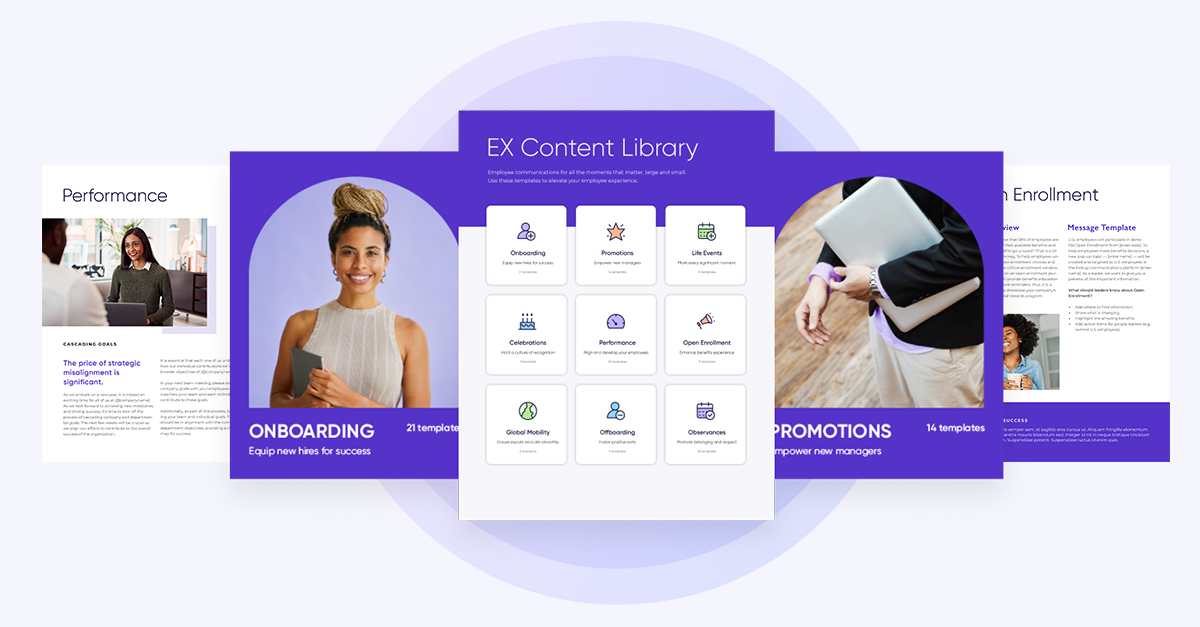Rolling out a new communication program comes down to two things:
- Clear objectives
- Careful pacing
It’s tempting to go “all in” when launching your new initiative. After all, you’re excited about a cool, new tool that will transform how the company engages with employees.
We don’t mean taking it slow, by the way. A better description is taking a deliberate approach. So, let’s take a closer look at four key questions you should consider to ensure a successful launch.
1. How do you want to change your company communication?
Before raising the curtain of a new system in front of an employee audience, it’s important to understand where they stand today. What programs/software are you currently using to communicate with your employees? Take a tally of channels such as the intranet, corporate email, collaboration platforms, in-person signage, company newsletters, and so on.
What seems to be most effective about them and where are they falling short? Once you have a clear picture of your current landscape, you can determine which of those programs you can sync with your new communication platform. You’ll want to create a more integrated communication plan that streamlines the way you engage the workforce. This should not be just throwing another tool into what might already be a confusing communication mix.
2. What timeline offers the best chance of success?
When rolling out a new communication program, you will likely want to start with a smaller “beta” group for at least the first few weeks. This group serves as a test case before launching to the whole company. You can take what you learn from this pilot group to have a solid plan for the company-wide launch. It’s a great opportunity to work out any bugs so that the larger rollout happens like clockwork. A beta group also allows you to chart adoption trends and ensure that you have enough strong, interesting content to keep employees engaged and coming back for more.
Depending on the size of your company, you could start with a few hundred employees who are will find obvious value in the program. This group should include a mix of employees who are representative of the company as a whole: some connected workers, some dispersed workers out in the field. (Pro tip: Include Comms/Marketing team members so they can deliver feedback from a best-practice perspective.) Also, make clear that you want feedback from this initial group so you can fine-tune your plan for the bigger launch. You want their help to make this even better.
The goal is to build a solid plan for organization-wide expansion and test communication strategies. You can also use the beta phase as a benchmark to set goals and objectives throughout your first year. Measuring results will give you the data to see what’s working and what’s not.
Phased rollout vs. company-wide rollout
After your initial test, you’ll have an important decision to make. Are you going to gradually roll out the program throughout the company piecemeal, or are you going to introduce it to the entire company all at once? There’s no right or wrong answer. It depends entirely on the structure of your organization. Here are some things to consider when deciding what’s best:
- How are regions mapped within your org? For instance, are they multinational, such as EMEA, or county-specific?
- Which departments exist across your organization?
- Which departments/regions are highly engaged? If planning a phased rollout, start with most-engaged segments first (Pro tip: If there are existing Ambassador programs or social media users, include them in the first phase. They will help you drive adoption.)
You should also identify the potential champions who can help promote the rollout. Mobilizing people who are most excited by the new communication program will create enthusiasm throughout the organization. They can play the role of “town criers” who spread the word some something great is coming.
Benefits of a phased rollout
This allows you to be more methodical about introducing the system to employees; more time and effort can be spent making sure a new division/region/segment is fully up and running before turning your attention to the next group. Best practices and lessons learned as you go along can be used to make the process smoother over time
Benefits of a company-wide rollout
You’ve got a great new program. Everyone is excited. Why make them wait! Also, there’s something to be said about introducing a big initiative at the same time. There can be a sense of camaraderie with the entire company learning at the same time. Also, the faster employees are brought on board, the faster they will be getting needed information.
3. Which senior leaders should be involved in the rollout?
This point needs to be absolutely clear: Executive sponsorship is crucial for a successful launch and long-term adoption. Nothing else matters more than this. So, it’s important to have well-defined ownership of the project, starting with the most senior executive as well as other key stakeholders who will play a role.
The overall program should be owned on a global/corporate level with guidelines in place for the various business segments (region, department, product line, and so on). All stakeholders must be aware of the goals. Because this is a communication project, the comms teams from each business segment need to be actively involved as they disseminate targeted information to their employee groups from the ground level.
4. How can we best promote this to the company?
Communicate value to internal key stakeholders
Promotion should happen before, during, and after your program is launched. You also should take a two-fold approach to buy-in – focusing on both program stakeholders and employees. This process should begin weeks in advance of the launch.
Identify the key program administrators and explain their role in helping ensure that promotional objectives are met, This should happen at least one month before implementation. Explain their role in ensuring that promotional objectives will be met. In an ideal world, this should be on their radar at least one quarter in advance of the launch. It needs to be crystal clear that this is a vital project for the company and will help drive business objectives forward. A successful launch is important, and there needs to be complete buy-in on their part.
Value propositions
- How this benefit the program owners
- What problems it solve for them
- What problems it solve for the employees
- The overall benefit to the company
Benefits and solutions
- Centralizing communication and measuring those efforts
- Ease of use and management both for communicators and employee
- Segmenting content per employee to cut through the noise
- Humanizing the executive team
- Time and cost savings
Roadmap and metrics
- Define clear timelines for rollout
- Establish adoption and success metrics
- Explain how stakeholders will be measured
A promotional campaign for the employees
Share the news about the upcoming launch with your workforce on existing communication channels including newsletters, internal advertisements, and platforms (Firstup, Slack, Teams, and so on). Encourage executives to also communicate the values within emails, town halls, meetings, and company updates. This is where that initial buy-in is important. Leaders can serve as ambassadors for what’s to come. If they’re enthused, there’s a greater chance that employees will be excited, too.
Key points to stress with employees:
Value propositions
- How this initiative benefits employees
- How it will help them do their jobs better
- How it will help the company
- How they will use it?
Benefits and solutions
- More informed about the company
- Stay up-to-date on safety issues
- Contribute and share your story
- Share content with your social audiences
5. What does success look like?
What are the key performance indicators for your organization? It’s a simple question. But having clear goals established will help set reasonable and achievable implementation goals for the launch of your communication program. Establishing objectives, right from the start, can make a huge difference.
- Consolidate existing systems within this new platform?
- Adoption metrics after three months, six months, one year?
- Persuade employees to migrate over from communication other channels?
- Accurately measure employee engagement with new platform
Some closing advice
No matter how you decide to roll out your new communication program, it’s important to remember two important points:
- Keep it simple. Implementing an overly complicated content strategy can muddy the value and confuse people. You will never get a second chance to make a first impression.
- Rely on your key stakeholders. Executives, team leads, and other catalysts play a large role in your ability to quickly share the value of your program. Get their buy-in.
If you have the answers to these questions, you’ll be well on your way to rolling out a successful communication program!





